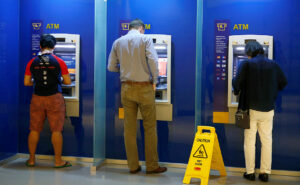




Inflation Update: Green light for easing
 DOWNLOAD
DOWNLOAD

December Economic Update: One for them, one for us
 DOWNLOAD
DOWNLOAD

Philippines Trade Update: Trade trajectories trend along
 DOWNLOAD
DOWNLOAD


Bank lending growth slows in December as interest rates rise

GROWTH in bank lending slowed in December, data from the Bangko Sentral ng Pilipinas (BSP) showed, reflecting the impact of higher interest rates.
Outstanding loans issued by universal and commercial banks increased by 13.4% year on year to PHP 10.9 trillion in December, slower than the revised 13.9% growth in November.
Big banks’ outstanding loans — lending net of reverse repurchase (RRP) placements with the BSP — slipped by 0.4% month on month.
“Bank lending continues to expand, albeit at a slightly slower pace. BSP’s rapid fire rate hikes appear to be sapping bank lending growth as expected, as the lagged impact takes hold,” ING Bank N.V. Manila Senior Economist Nicholas Antonio T. Mapa said in an e-mail.
The Monetary Board hiked borrowing costs by 50 basis points (bps) in December, adding to the total 350-bp rate increase in 2022.
This brought the interest rate on the BSP’s overnight reverse repurchase facility to 5.5%, while rates on the overnight deposit and lending facilities are now at 5% and 6%, respectively.
BSP data showed outstanding loans to residents, net of RRPs, grew by 13.2% to P10.58 trillion in December, slower than the revised 13.6% print in November.
Credit for production activities jumped by 12.1% to PHP 9.56 trillion, slowing from the revised 12.6% growth in November.
Banks extended more loans for real estate activities (13.1%); manufacturing (14.9%); electricity, gas, steam and air-conditioning supply (14.4%); motor vehicles (12.7%); and information and communication (21.6%).
Meanwhile, consumer loans to residents rose 24.8% to PHP 1.03 trillion, faster than the revised 24.2% in November. This was mainly driven by the increase in motor vehicle loans (11.5%) and salary-based general purpose consumption loans (63.8%).
However, credit card loans grew by 26.3% in December, although slowing from 26.6% in November.
“Bank lending growth numbers are also partly supported by heavy lending to consumer credit, in particular credit cards which posted yet another month of substantial gains,” Mr. Mapa said.
“One reason for the strong growth of this sector is the fact that BSP capped credit card rates at 2%, which means lending to that sector remained unaffected by BSP’s aggressive tightening,” he said.
The central bank had kept the monthly interest rate ceiling on credit card transactions at 2% per month for the last two years.
Meanwhile, outstanding loans to nonresidents net of RRPs expanded by 20% to P321.632 billion in December, slower than the revised 24.6% growth in the previous month.
“In the coming months, we can expect bank lending, especially for lending to ‘productive sectors’ slow further as rate hikes bite. Meanwhile, bank lending will likely slow also as consumer credit loans via credit cards may also be impacted by the BSP’s decision to increase the rate cap on credit cards to 3%,” Mr. Mapa said.
The Monetary Board in January raised the monthly ceiling for credit card charges to 3% to reflect the BSP’s policy tightening and to mitigate the impact of inflationary pressures on banks and credit card issuers.
“This is the byproduct of raising rates to quell inflation: slowing lending to productive sectors and eventually slower growth. Slower and lesser lending to productive sectors means less jobs, less expansion and eventually less productive capacity,” Mr. Mapa said.
While this move would help temper inflation, he noted it would come at the cost of growth momentum.
Mr. Mapa expects bank lending to further moderate as the BSP is likely to continue tightening in the first half of the year.
BSP Governor Felipe M. Medalla earlier signaled more policy rate increases in the first quarter this year to ensure inflation falls within the 2-4% target range by the second half.
The Monetary Board will have its first policy review on Feb. 16.
FASTER M3 GROWTH
Meanwhile, domestic liquidity grew by 6.4% year on year to P16.3 trillion in December, the BSP said in a separate statement. This is faster than the revised 5.5% expansion seen in November.
M3 — which is the broadest measure of money supply in an economy — picked up by 0.9% month on month in December.
Domestic claims rose by 12.5% in December from the revised 11% in the prior month.
Net claims on the central government climbed by 21% in December, from 13.8% in November.
Meanwhile, growth in claims on the private sector quickened to 10.5% in December, a tad slower from the revised 10.6% in the previous month.
Net foreign assets (NFA) increased by 3.5% in December from the revised 1.5% expansion a month earlier.
“The NFA of banks fell mainly on account of higher bills payable. Similarly, the BSP’s NFA position contracted by 3.4% in December,” the BSP said.
“Looking ahead, the BSP will ensure that domestic liquidity conditions remain appropriate to support the prevailing stance of monetary policy, consistent with the BSP’s price and financial stability objectives,” it added.
Rizal Commercial Banking Corp. Chief Economist Michael L. Ricafort said M3 may continue to expand this year if the BSP cuts banks’ reserve requirement ratio (RRR) in the second half.
“Recent hints about a possible -2 percentage point cut in large banks’ RRR in 2H 2023 (from the current 12%)… would infuse about P260 billion in the financial system (or about P130 billion for every -1 percentage point cut in the said RRR) that could add to domestic liquidity,” Mr. Ricafort said.
Mr. Medalla earlier said there is a high probability that there will be a reduction in the banks’ RRR in the first semester of 2023.
A cut in RRR is a move intended to be an operational adjustment to facilitate the BSP’s shift to market-based instruments for managing liquidity in the financial system, particularly the term deposit facility and the BSP securities.
The RRR for big banks is currently at 12%, one of the highest in the region. Reserve requirements for thrift and rural lenders are at 3% and 2%, respectively. – Keisha B. Ta-asan, Reporter
This article originally appeared on bworldonline.com





 By BusinessWorld
By BusinessWorld